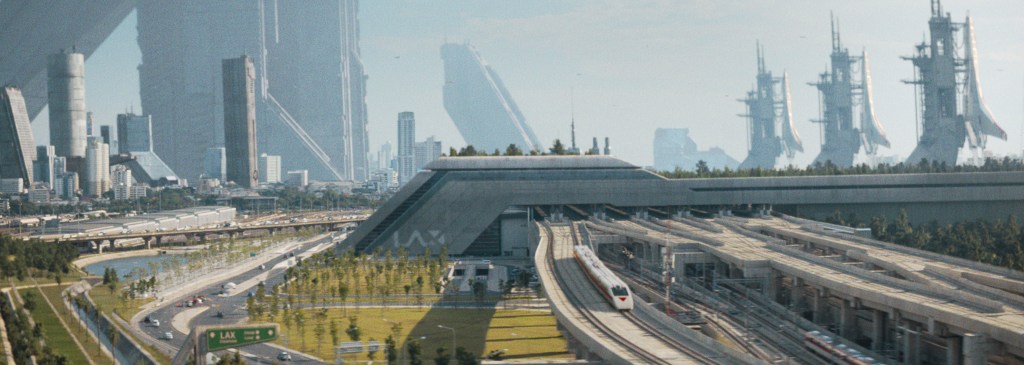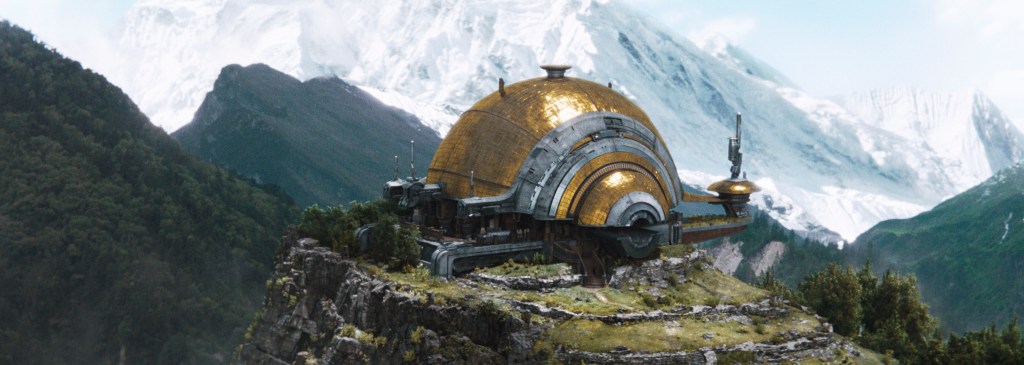At last, Gareth Edwards has made a movie that’s as good as everyone says it is; the humanist science-fiction war movie that Rogue One wasn’t and could never be, so long as it was burdened with so much Star Wars continuity and so many in-universe rules. The Creator feels closer to the early work of Neill Blomkamp than Edwards, who made his name with Monsters and Godzilla, two monster movies that infamously don’t show the title creatures much. Here, he doesn’t skimp, giving us epic futuristic vistas in every scene. It all looks like an open-world video game you can fully take the time to imbibe with your eyes, because nobody’s going to shoot you in the back if you just sit still and stare.

Visuals alone do not a movie make, but they certainly help, and they work best if the director knows when and how to employ them. Edwards eases us in with faux-documentary newsreels and broadcasts that chart a future history of robots developing to the point that they become convincing human replicas. Humanity uses them as slaves, basically, seeing them as mere devices and programming who do not feel or think, but merely replicate such behavior.
AI-yi-yi!
And then the robots nuke Los Angeles. Edwards couldn’t possibly have timed his film’s release to strikes by workers in L.A.’s biggest industry who are protesting the use of AI, but it’s the film’s best accidental meta-joke. Anyway, the American military overreacts, as it is frequently wont to do in such movies, and the AIs flee to “The Republic of New Asia,” because calling it Vietnam would be too on the nose. (It’s shot in Thailand.)
The U.S. continues to fight the AI by shooting at them from space with a weapons platform called NOMAD, a mini All-American Death Star straight out of Ronald Reagan’s most high-concept fantasies. But as our military should have learned from the experiences of the ’70s, big expensive guns aren’t necessarily going to root out insurgent guerillas who know the local terrain. Unless you know where to aim.

Where Is the Rebel Base?
Hence the use of Joshua (John David Washington), an undercover operative on a mission to find “Nirmata,” the mysterious deity figure worshipped by the AI units. The first time around, things don’t go so well, and Joshua’s not really down for a second go-around until he sees footage of his long-lost love Maya (Gemma Chan) in the war zone and figures there’s a chance to get her out of there. Nirmata, like a sort of android Oppenheimer, apparently now has a new ultimate weapon to decisively win the war on behalf of AI. And even though Josh’s first mission failed, he got closer than anybody else. If he can just remember where the secret base is that would store such a doomsday device.

When he gets there, however, all he finds is a little kid (Madeleine Yuna Voyles). Though the hole in her neck marks her as a “simulant,” which is to say humanoid AI, she’s advanced far beyond any previous designs, able to grow older and manipulate electrical devices to a limited degree. Dubbing her “Alphie” for the alpha symbol on her neck, Joshua determines that she must surely be able to lead him to Maya, so the two take off on a perilous journey. The AI troops will know him as an enemy, while his American comrades think he’s a traitor for not destroying the kid/weapon right away.

RoboGod
As perhaps may be evident by now, Edwards takes the Vietnam war allegory from Return of the Jedi, and makes it way more Vietnam-y. Yet if that were all the thematic heft the film had, it might be as insufferable as Monsters’ on-the-schnoz immigration metaphors. Edwards has a lot more on his mind, however – his story is essentially, from the AI point of view, a new Holy Scripture about a robot Messiah, the miracle-working child of their god. To a lesser extent, of course, it also fits the current fad for apocalyptic narratives about an initially reluctant protector and a special child on the run (a la The Mandalorian or The Last of Us).
James Clyne makes his debut as a production designer on The Creator, after years of art department work on movies like Avatar, Alita: Battle Angel, and Transformers. Alita’s influence is certainly felt here, along with a lot of District 9, Avatar, Blade Runner, and given the setting, some Apocalypse Now thrown in. It’s a lived-in universe, where even the high technology looks well-used, but for the sake of keeping the allegory simple, it’s notable that all the AI characters are either explicitly humanoid or at least human shaped. A HAL-9000 or Megatron might win the war more quickly, but they would blur the more obvious “they’re just like us” subtext. The army does operate the cutest walking bombs this side of Super Mario World, but they’re explicitly designated as not AI.
Prime Cuts
Using title cards and visual cues, Edwards goes more nonlinear than usual here, jumping back in time to fill in bits of backstory right as they’re needed and experimenting with different ways of storytelling. He augments this with lots handheld, close camerawork that contrasts with the slow pans across larger spectacles, but it all works — rarely is it unclear what is happening, or when, though with all the rapid laser fire, one does wonder how anybody manages to survive. The laser blasters in this movie, more realistically than most, generate near instantaneous full beams, rather than firing short blasts Star Wars style.

On a side note: anyone susceptible to vertigo should be warned that the intense climax may trigger it.
In the end, all of Edwards’ creative gambles pay off. The Creator, while full of familiar elements, is an original, grand-scale sci-fi epic with strong spiritual elements that should satisfy most fans of the genre and generate at least as much of a rabid cult following as Alita. The last director to get away with this sort of thing after his big franchise films was Christopher Nolan. Edwards doesn’t have the same track record yet, but this definitely pushes him in that direction. It’s the sort of movie we always say we want. Now let’s go support it.
Grade: 5/5
The Creator opens in theaters Sept. 29th.




